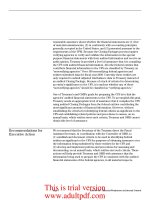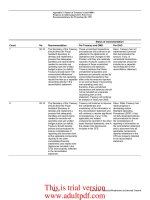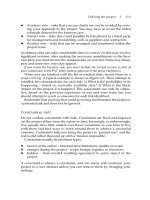The Handbook of Management and Leadership
Bạn đang xem bản rút gọn của tài liệu. Xem và tải ngay bản đầy đủ của tài liệu tại đây (1.61 MB, 242 trang )
“He is without doubt one of
the foremost thinkers on the
subject in the world”
SIR JOHN HARVEY-JONES
JOHN
ADAIR
handbook of
MANAGEMENT and LEADERSHIP
The
EDITED BY NEIL THOMAS
Inside front cover
The
John Adair
Handbook
of
Management
and Leadership
Edited by Neil Thomas
Thorogood
10-12 Rivington Street
London EC2A 3DU
Telephone: 020 7749 4748
Fax: 020 7729 6110
Email:
Web: www.thorogood.ws
Thorogood is a division of Acorn Magazines Ltd.
© John Adair 2004 – edited material in
this format, John Adair, Neil Thomas
and Thorogood Ltd
All rights reserved. No part of this publication
may be reproduced, stored in a retrieval system
or transmitted in any form or by any means,
electronic, photocopying, recording or otherwise,
without the prior permission of the publisher.
This book is sold subject to the condition that it
shall not, by way of trade or otherwise, be lent,
re-sold, hired out or otherwise circulated without
the publisher’s prior consent in any form of
binding or cover other than in which it is
published and without a similar condition
including this condition being imposed upon the
subsequent purchaser.
No responsibility for loss occasioned to any
person acting or refraining from action as a result
of any material in this publication can be
accepted by the author or publisher.
A CIP catalogue record for this book is available
from the British Library.
PB: ISBN 1 85418 204 8
HB: ISBN 1 85418 004 5
Printed in India by Replika Press
Designed and typeset by Driftdesign
Special discounts for bulk
quantities of Thorogood
books are available to
corporations, institutions,
associations and other
organisations. For more
information contact
Thorogood by telephone
on 020 7749 4748, by fax on
020 7729 6110, or email us:
For information on
seminars and training
with the John Adair
Leadership Foundation,
see www.falconbury.co.uk
For information about
John Adair and
products/services, see
www.johnadair.co.uk
Contents
Part 1
Self-management
Chapter ⅷ
1
Time management
Introduction 4
Tempus Fugit 4
Basic approach to time management 4
Developing a personal sense of time 6
Time audit 6
Analyse and improve your use of time 9
Identifying long-term goals 9
Making medium-term plans 11
Smarter objectives 12
Planning the day 13
The Adair urgency/importance matrix 14
Tips on daily planning 15
Making the best use of your best time 16
Organising office work 17
Dealing with interruptions 17
Dealing with paperwork 17
Other elements to improve your
time management in the office 18
Managing meetings 19
Delegating effectively 21
Deciding what to delegate 22
Making use of committed time 24
Managing your health 24
How topped up are your batteries? 25
Stress 25
Summary and six-month follow-up test 28
Chapter ⅷ
2
Setting and achieving goals and objectives
Introduction 32
Personal goals and objectives 32
Professional/business goals and objectives 35
Summary and six-month follow-up test 39
Chapter ⅷ
3
Decision-making and problem-solving
Introduction 42
Decision-making skills 42
The Manager as decision-maker 44
Key elements of effective thinking and decision-making 46
Analysis 46
Synthesis 47
Other useful approaches 48
Imagination 48
Conceptual thinking 49
Intuition 50
Originality and Innovation 50
The concept of value in decision-making 50
Decision-making and weighing up the options 52
Summary and six-month follow-up test 54
Chapter ⅷ
4
Creativity and innovation
Introduction 58
Creativity 59
Innovation 62
Recruit/select creative people 63
Encouragement of creativity in teams 64
Team training 65
Communicating about innovation 65
Overcoming obstacles to innovation 66
Organisation and Innovation 66
The Generation of ideas 71
Characteristics of innovators 75
Summary and six-month follow-up test 76
Chapter ⅷ
5
Part 1: Personal reminders and thoughts worth thinking
Introduction 80
Time management 80
Setting and achieving goals and objectives 94
Decision-making and problem-solving 98
Creativity and innovation 100
Part 2
Managing others
Chapter ⅷ
6
Leadership and teambuilding
Leadership 118
Qualities of leadership 120
Functions of leadership 123
Leadership characteristics 127
Leadership skills 129
Defining the task 129
Planning 131
Briefing 132
Controlling 134
Evaluating 135
Motivating 138
Organising 139
Setting an example 142
Developing leadership skills 143
Teambuilding 144
Task 146
Team 147
Individual 149
Summary and six-month follow-up test 153
Chapter ⅷ
7
Motivation and people management
Introduction 156
The 50:50 rule 157
Needs and motivation 158
Maslow’s hierarchy of needs 158
McGregor’s Theory X and Theory Y 159
Herzberg’s motivation – hygiene theory 160
Managers/leaders and motivation 163
Getting the best from people 165
Be motivated yourself 165
Select people who are highly motivated 166
Treat each person as an individual 167
Set realistic and challenging targets 168
Remember that progress motivates 170
Create a motivating environment 171
Provide fair rewards 172
Give recognition 173
Summary and six-month follow-up test 174
Chapter ⅷ
8
Communication and presentation
Introduction 178
Issues in communication 178
Listening 180
Reading skills 182
Writing skills 183
Speaking and presentation skills 186
Effective speaking 186
Presentation skills 187
One-to-one interviews 192
Managing meetings 193
Within your organisation 195
Summary and six-month follow-up test 196
Chapter ⅷ
9
Part 2: Personal reminders and thoughts worth thinking
Introduction 200
Leadership and teambuilding 200
Motivation and people management 214
Communication and presentation 220
Chapter
ⅷ
1
Time management
ⅷ
2
Setting and achieving goals and objectives
ⅷ
3
Decision-making and problem-solving
ⅷ
4
Creativity and innovation
ⅷ
5
Part 1: Personal reminders and
thoughts worth thinking
Part 1
Self-management
Blank
Chapter 1
Time management
Introduction
Developing a personal sense of time
Identifying long-term goals
Making medium-term plans
Planning the day
Making the best use of your best time
Organising office work
Managing meetings
Delegating effectively
Making use of committed time
Managing your health
Summary and six-month follow-up test
Introduction
Time management is about managing your time with a focus on
achievement: of doing and completing those things which you
want to do and which need doing.
Time management is goal-driven and results oriented. Success in
time management is measured by the quality of both your work and
your personal life.
Tempus Fugit
Whilst it is true to say that life only makes sense in retrospect, it can
be shaped by your sense of time and purpose. In keeping with
business planning, time planning – and your approach to the use
of your time (and to the extent that you can influence it, how
others spend their time) – should be to avoid the trap of failing to
plan, which is, in effect, planning to fail. In other words, if time is
money, spend it wisely.
Basic approach to time management
You need to be certain that you:
• can define your business role and know what constitutes to a
successful outcome
• spend time thinking and planning for yourself and others
• have a clear understanding of your business purpose
• know the balance you wish to achieve between your business
and your private commitments (and can identify the time
demands on both).
4
The John Adair Handbook of Management and Leadership
5
Chapter 1: Time management
At all costs you should avoid falling into one of the following
stereotypes:
• a poor delegator
• a bad organiser
• an excellent procrastinator
• a poor performer at meetings
• a purposeless executive.
The
Adair ten
principles
of time
management
1 Develop a personal sense
of time
2 Identify long-term goals
3 Make medium-term plans
4 Plan the day
5 Make the best use of your
best time
6 Organise office work
7 Manage meetings
8 Delegate effectively
9 Make use of committed
time
10 Manage your health
Developing a personal sense of time
First audit how you spend your time, then analyse how you can
improve your use of time.
Time audit
Keep a record (a daily time log) of where your time currently goes
– break your day into fifteen minutes chunks for recording purposes.
Do this for a week or so and review after each batch of three or
four days.
Reproduced from Keytime Time Management
with the kind permission of Keytime Management Developement
6
The John Adair Handbook of Management and Leadership
Peter Drucker’s view is that only when we can manage time can we
manage anything. In managing time we first need to know how we
use it now and then change what and when we do things.Your time
audit will probably confirm the findings of an IBM research which
showed that the four activities that take up over 50% of the average
executive’s time are:
1 Meetings
2 Reading and writing business materials
3 Telephoning
4 Travelling.
Your time audit can identify these and others by using symbols
ascribed to activities, for example:
M Meetings (in committee form)
Mi Meetings (in one-to-one interview form)
F Finance and figure work
T Telephone
Wr Writing (reports)
Wd Writing letters or dictation
T Travelling
R&d Research and development
(including reading, training and thinking)
AOB Any other business activity (should be specified)
7
Chapter 1: Time management
Your time log can then be summarised in the following format:
Activity Time Spent % of time Comment
(in hours) (how to save time from now on)
8
The John Adair Handbook of Management and Leadership
Research indicates that we make assumptions about where our
time goes and overestimate time spent on telephone calls,
correspondence, report writing and planning, but underestimate time
spent in meetings and one-to-one discussions. Keeping a record will
confirm how you really spend your time and enable you to change
how you spend it.
Analyse and improve your use of time
What elements can you readily identify which you can immediately
change? Experience shows that improvements lie in changing the
way you handle: interruptions (in person or by the telephone);
meetings; travel; and incoming/outgoing mail. You can improve
your use of time if you ensure that:
1 your time is spent according to a clear idea of your priorities
and main responsibilities
2 you isolate the unimportant and ruthlessly prune out
unnecessary or unproductive activities
3 you combine any ‘free’ time (ie free from meetings or other
people’s demands) to create meaningful and usable time of your
own
4 tasks are simplified where others would not be adversely affected
5 you are not doing tasks which could be performed by others.
The balance of this chapter looks at how to ensure you improve your
time management. The approach taken is to work from the long-
term back to the immediate future, analysing your goals and gives
time management tips on how to achieve them. (The approach works
for both business and personal time management).
Identifying long-term goals
First of all, it is necessary to define your organisation’s purpose and
the purpose or your job, ie to what end is your time being expended.
Then, long-term goals can be set in terms of the results that the
organisation wishes to achieve (and your role as part of those goals
being achieved).
9
Chapter 1: Time management
Defining the purpose of your organisation requires an answer to the
basic question: why does this organisation exist? You should be able
to write this business purpose down:
Defining the purpose of your own jobs requires an answer to the
question: why does my job exist? Again, you should be able to write
this purpose down:
10
The John Adair Handbook of Management and Leadership
Identifying long-term goals, the strategy of your business and your
part in it, will result from pondering these questions:
These same questions can be applied to your personal life
The answers to these questions will help you identify long-term goals.
The longer the time frame the more fuzzy the goals become, so you
should then reduce your field of vision to focus on tangible,
attainable, definable and measurable goals, but not lose sight of the
far ground.
are we now?
do we want to be in 3 or 5 year’s time?
strengths and weaknesses do we have?
can we improve?
can we get to where we want to be?
Where
What
How
You should reach a point where you can be clear about long-term
aims/directions and medium, or short term goals/objectives which
will be met and which will be part of a plan to continue on the road
of achieving your longer-term aspirations.
Making medium-term plans
Your key areas of responsibility (and how your performance will
be measured) should be listed and for each you must set objectives
with time budgeted for each.
a
b
c
a
b
c
a
b
c
a
b
c
5
a
b
c
a
b
c
a
b
c
a
b
c
4
a
b
c
a
b
c
a
b
c
a
b
c
3
a
b
c
a
b
c
a
b
c
a
b
c
2
a
b
c
a
b
c
a
b
c
a
b
c
1
Review of
objective
achievements
Time
budgeted to
achieve each
objective
Objectives
for each
area of
responsibility
Key area of
responsibility
11
Chapter 1: Time management
The review of objective achievement (the measure of your
performance) should be at the intervals you have budgeted for each
(eg 3, 6 or 12 months).
Smarter objectives
As a test of your objective-setting skills, remember they need to be
Smarter, to the power of two, ie Smarter
2
:
12
The John Adair Handbook of Management and Leadership
Specific
Measurable
Agreed
Realistic
Time-bounded
Evaluated
Reviewed
Strategic
Meaningful
Attainable
Rewarding
Teambuilding
Empowering
Rewarding
Part of all this is to set out clear ways in which time management
can be improved in the short to medium-term. A ‘Time Norm’ form
can help here.
Task/activity/procedure Time taken now Target time
When measuring and assessing improvements you cannot lose sight
of the cost and quality dimension.Time improvements should not
compromise standards set for those elements. Real improvement
comes from keeping all three at whatever is decided are the
acceptable levels.
Being successful in making medium-term plans requires you to:
• know the context (the longer-term) in which you operate and
how the medium and longer-term goals are linked
• be able to plan and implement activity
• set clear objectives and review progress toward them on a regular
basis
• be flexible and adaptable to change in order to stay on course
to meet objectives (unless you have changed those, too!)
Planning the day
The golden rule is to plan an outline for each day a week ahead,
but plan for the day in detail the day/evening before it, or at the
beginning of it.
In setting your programme for the day you need to establish
priorities related to urgency and importance. If you then spend
time according to how you have set your priorities, you will have
addressed the important jobs – that is the art of time management.
13
Chapter 1: Time management
The Adair urgency/importance matrix
In the matrix you can identify tasks to:
1 do now
2 plan for (to use quality time)
3 do quickly (not requiring quality time)
4 do later or perhaps delegate.
This approach has also been called the Four-D system:
Drop it, Delay it, Delegate it or Do it.
You should shape your plan for the day by listing the various
components, prioritising them and planning the time accordingly.
Urgent Less urgent
Low Priority (4)
Less urgent and less important
a
b
c
Medium Priority (3)
Urgent but less important
a
b
c
Less
important
Medium Priority (2)
Important but less urgent
a
b
c
Top Priority (1)
Important and urgent
a
b
c
Important
14
The John Adair Handbook of Management and Leadership
Your plan of action for the day should follow these rules:
• Make your plan at the end of the previous day or at the start
of each day (whichever best suits you) enabling you to assess
any unfinished work, together with upcoming priorities
• List the main elements (in relation to yesterday’s, today’s and
the week’s plans)
• Prioritise those main elements and identify tasks according to
the matrix 1, 2, 3 and 4 above
• Group items together (eg telephone calls, correspondence)
• Decide when you will do the top priority tasks and block time
out to do them
• Decide on remaining tasks (and share your plan with
assistants/staff as relevant).
At a very basic level your list should also include your own system
for identifying what must be done today, should be done today
and what might be done today.
During the course of the day, regularly ask yourself whether you
have changed priorities deliberately or whether you need to get back
on course and tackle what remain as being prioritised activities.
Think of any daily list as a kind of shopping list – how are you going
to feel going home without an item being ticked off as done?
However, do not be fixed and inflexible, provided you have managed
your time and time has not mismanaged you.
Tips on daily planning
Tips on day-to-day planning and your programme centre on
whether you are achieving at least your main priority activities.
15
Chapter 1: Time management









